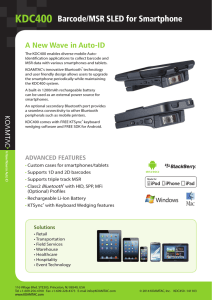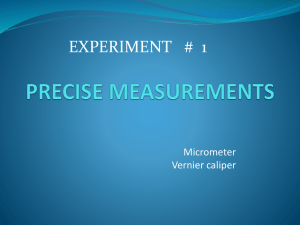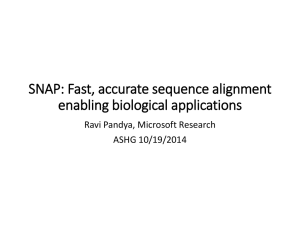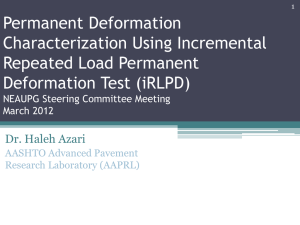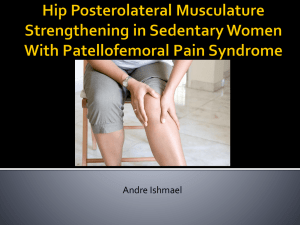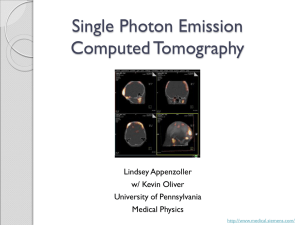Small photon field dosimetry: present status
advertisement
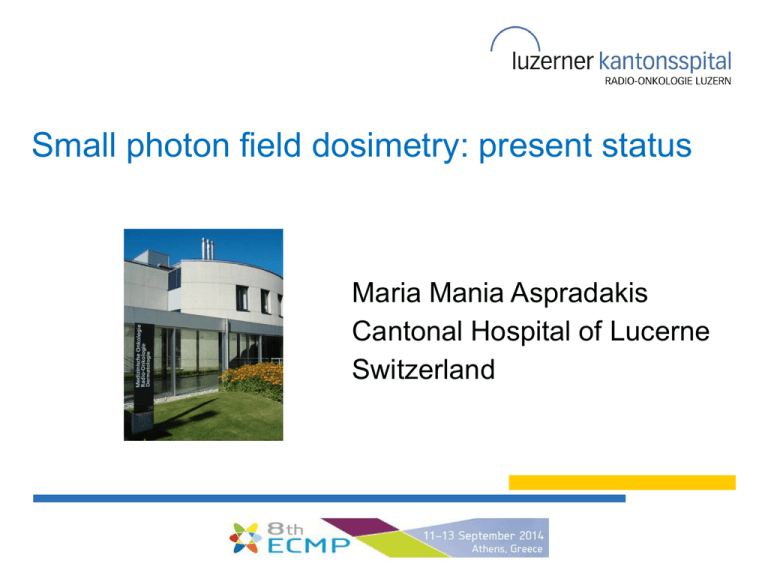
Small photon field dosimetry: present status Maria Mania Aspradakis Cantonal Hospital of Lucerne Switzerland IPEM report 103: main scope • Educate on the physics and challenges in the dosimetry of small MV photon fields. • Review commercially available detectors and measurement methodologies suitable for implementation in the clinic. • Give recommendations of good practice in order to reduce uncertainty in the determination of dosimetric parameters • Explain the need to commission TPSs specifically for small fields. • To point out directions along which future work and research efforts are required in this challenging field of dosimetry. Aspradakis M, IDOS, IAEA, Vienna, Nov 2011 Other reviews on small field dosimetry R. Alfonso, P. Andreo, R. Capote, M. S. Huq, W. Kilby, P. Kjäll, T. R. Mackie, H. Palmans, K. Rosser, J. Seuntjens, W. Ullrich, and S. Vatnitsky, “A new formalism for reference dosimetry of small and nonstandard fields,” Med. Phys. 35, 5179–5187 (2008). I. J. Das, G. X. Ding, and A. Ahnesjö, “Small fields: Nonequilibrium radiation dosimetry,” Med. Phys. 35, 206–215 (2008). H Palmans (2011) CN-182-INV006, Small and composite field dosimetry: the problems and recent progress. IDOS Conference, Vienna. Outline of presentation • Small MV photon field conditions • Present status on: reference dosimetry output factor determination Discussion in this presentation restricted to dose determination in static MV photon fields Small MV photon field conditions • For the selected energy and medium, the field size is not large enough to ensure lateral CPE (lack of LEE). • The entire source is not in the detector’s-eye-view (source occlusion). • The detector is not small enough and perturbs fluence significantly (detector issues) Detector size relative to field size Small field conditions exist when one of the edges of the sensitive volume of a detector is less then a lateral charged particle equilibrium range (rLEE) away from the edge of the field rLEE g cm 2 5 .973 TPR 20 10 Li et. al., Med. Phys. 22, (1995), 1167-1170 2 . 688 Slide courtesy: H. Palmans In narrow fields: source occlusion source occlusion by the collimators point source used in calculation finite source size used in calculation Very narrow dose profile Partial view of extended direct beam source from the point of measurement Treuer et al PMB 38 (12), 1992 Radiation detector measures in nonuniform dose region Overlapping penumbras apparent field widening Das et al., Med. Phys. 35: 2008, 206-15 definition of field size? Uncertainty in output factor correction introduced due to field size definition Cranmer-Sargison et al, Med. Phys. 38, 2011. 6592-6602 Benhmakhlouf et al, Med. Phys. 41,2014, 041711 Slide courtesy: H. Palmans Detector issues in small field dosimetry • Energy dependence of detector response • Perturbation effects Volume averaging Ionization chambers: wall, central electrode, air cavity different from water Solid state detectors (e.g. diodes): housing, shielding, coating of silicon chip Detector issues in small field dosimetry Perturbation effects: volume averaging 2.5 mm 5 mm 5.8 mm 6.6 mm 16.25 mm 23 mm 0.3% 1.4% Pantelis el al, Med Phys 37 (5), (2010) Correction for volume averaging Azangwe et al, Med. Phys. 41, 072103 (2014) A correction for volume averaging can be derived from the ratio of the detector response in its central part to the detector response over its whole volume Georg et al, 2nd ESTRO Forum, Pre-meeting workshop 2013 Correction for volume averaging Morin et al MP, 40(1), 2013 Ralston et al PMB, 57, 2012 Detector issues in small field dosimetry Perturbation effects: detector construction Crop et al., Phys Med Biol 54:2951 (2009) C. McKerracher & D.I. Thwaites Radiotherapy and Oncology 79 (2006) 348–351 Detector perturbation the influence of detector density at small field sizes D water voxel D detector in water voxel in water D water - voxel in water D water - voxel with detector density in water Scott et al PMB, 57 (2012) 4461-4476 15MV Small field reference dosimetry IAEA/AAPM formalism for reference dosimetry Small static MV fields: reference dose determination Alfonso el al (2008), Med Phys 35 (11) f msr machine specific reference field Q msr beam quality of machine specific reference field msr ref D w,msrQ msr M Q msr N k k D, w, Q o Q, Q o Q msr , Q msr f f f ,f IAEA/AAPM formalism for reference dosimetry field instrument correction factors k f msr , f ref Q msr , Q N D, w, Q msr N D, w, Q D f msr w, Q msr pcsr M f msr Q msr M D f ref w, Q f ref Q ref detector field instrument Determined through: •Experiment: by a primary standard •Experiment: using dosimeters that can measure reference dose traceable to a primary standard and which have sufficiently low uncertainty (alanine, radiochromic film, diamond, liquid ion-chambers ...) •Calculation: Monte Carlo simulations (MC) IAEA/AAPM formalism for reference dosimetry small static MV photon fields Reference dosimetry on Cyberknife: chamber factors calculated with MC Franscescon et al (2012), PMB 57 3741-3758 Gago-Arias el al (2013), Med Phys 40 (1), 011721-1, & Erratum Med Phys 40, 011721-1-10, 2013 f msr , f ref k Q msr , Q Exradin A12 PTW 30006 NE 2571 PTW 31014 PTW 31014 IBA CC13 Specification of a reference-class ionisation chamber Not all micro-chamber designs are considered suitable for reference dosimetry McEwen , Med Phys 37, 2010, 2179-93 Small field relative dosimetry - output factor , Scp 6 M V m e a s. re la tiv e D o s e 1 .0 0 .8 0 .8 IC P iP 0 .6 D iG re 0 .6 D iY e MOS1 0 .4 0 .4 MOS2 D IA 0 .2 0 .2 0 .0 0 .0 0 .5 1 .0 1 .5 2 .0 2 .5 0 .0 0 2 4 6 8 10 12 14 16 S E S / cm Sauer & Wilbert Med. Phys. 34, 2007, 1983-1988 18 IAEA/AAPM formalism for relative dosimetry output factor determination in small static fields D f clin w, Q clin D f msr w, Q msr f clin , f msr Q clin ,Qmsr f f clin D w,f clinQ M Q clin M Q clin clin clin f msr f f M Q msr D w,msrQ msr M Q clin msr M Qf clin f , f clin clin msr k Q clin , Q msr f msr M Q msr Small field detector specific correction factors Alfonso el al (2008), Med Phys 35 (11), new CoP: IAEA TECDOC### Small fields: relative dosimetry – output factor Scp Detector specific correction factors 6MV Siemens Elekta Francescon et al Med. Phys. 38(12), 2011 IAEA/AAPM formalism for relative dosimetry Small field detector correction factors Accounts for three main detector perturbation effects: k f clin , f msr Q clin , Q msr p vol Q Ratio of volume averaging correction factors Q clin msr p Q clin fluence Ratio of charged particle fluence perturbation correction factors Q msr p Q clin spectrum Q msr Ratio of correction factors to account for the spectral dependence of photon energy absorption in the detector medium p Only different degree in CPE & spectral effects considered Q clin fluence Q msr p Q clin spectrum Q msr These result confirm previous conclusions that unshielded diodes a better choice of detector than shielded diodes. The corrections for mini-ionization chambers used in this study (active volume between 0.015 cm3 and 0.05 cm3) were generally lower than 10% and for micro-chambers (active volume<0.015 cm3) lower than 3%. active volume > 0.1 cm3 corrections of 20%-30% ! Azangwe et al Med. Phys. 41 (7), 2014 IAEA/AAPM formalism for relative dosimetry Small field detector correction factors k f clin , f msr Q clin , Q msr Benmakhlouf et al Med. Phys. 41 (4), 2014 IAEA/AAPM formalism for relative dosimetry Small field detector correction factors p k f clin , f msr Q clin , Q msr p Q clin spectrum Q clin fluence Q msr Benmakhlouf et al Med. Phys. 41 (4), 2014 Q msr Summary & conclusions • Research in small field dosimetry, after the publication of IPEM report 103, has lead to improved understanding of detector response in such fields. • Current research efforts in small field dosimetry focus on the determination of detector-specific output correction factors. • Detectors requiring output corrections greater that 5% are not recommended for dose determination in small fields. • The new IAEA TECDOC will include a consistent set of such data and will be an international code of practice for small static field dosimetry. Thank you for your attention! ‘Sunset over the Libyan sea’, Ierapetra, Crete Maria.Aspradakis@luks.ch
